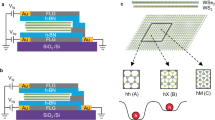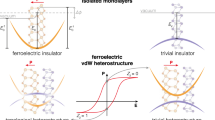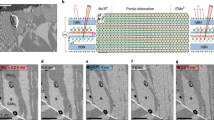Abstract
Moiré materials with superlattice periodicity many times the atomic length scale have shown strong electronic correlations and band topology with unprecedented tunability. Non-volatile control of the moiré potentials could allow on-demand switching of superlattice effects but has remained challenging to achieve. Here we demonstrate the switching of the correlated and moiré band insulating states, and the associated nonlinear anomalous Hall effect, by the ferroelectric effect. This is achieved in a ferroelectric WTe2 bilayer of the Td structure with a centred-rectangular moiré superlattice induced by interfacing with a WSe2 monolayer of the H structure. The results can be understood in terms of polarization-dependent charge transfer between two WTe2 monolayers, in which the interfacial layer has a much stronger moiré potential depth; ferroelectric switching thus turns on and off the moiré insulating states. Our study demonstrates the potential for creating new functional moiré materials by incorporating intrinsic symmetry-breaking orders.
This is a preview of subscription content, access via your institution
Access options
Access Nature and 54 other Nature Portfolio journals
Get Nature+, our best-value online-access subscription
$29.99 / 30 days
cancel any time
Subscribe to this journal
Receive 12 print issues and online access
$259.00 per year
only $21.58 per issue
Buy this article
- Purchase on Springer Link
- Instant access to full article PDF
Prices may be subject to local taxes which are calculated during checkout




Similar content being viewed by others
Data availability
Source data are provided with this paper. Additional data related to this paper are available from the corresponding authors upon reasonable request. Source data are provided with this paper.
References
Qi, L., Ruan, S. C. & Zeng, Y. J. Review on recent developments in 2D ferroelectrics: theories and applications. Adv. Mater. 33, 2005098 (2021).
Chang, K. et al. Discovery of robust in-plane ferroelectricity in atomic-thick SnTe. Science 353, 274–278 (2016).
Liu, F. C. et al. Room-temperature ferroelectricity in CuInP2S6 ultrathin flakes. Nat. Commun. 7, 12357 (2016).
Fei, Z. Y. et al. Ferroelectric switching of a two-dimensional metal. Nature 560, 336 (2018).
Li, L. & Wu, M. H. Binary compound bilayer and multilayer with vertical polarizations: two-dimensional ferroelectrics, multiferroics, and nanogenerators. ACS Nano 11, 6382–6388 (2017).
Yang, Q., Wu, M. H. & Li, J. Origin of two-dimensional vertical ferroelectricity in WTe2 bilayer and multilayer. J. Phys. Chem. Lett. 9, 7160–7164 (2018).
Ferreira, F., Enaldiev, V. V., Fal’ko, V. I. & Magorrian, S. J. Weak ferroelectric charge transfer in layer-asymmetric bilayers of 2D semiconductors. Sci. Rep. 11, 13422 (2021).
Zheng, Z. et al. Unconventional ferroelectricity in moire heterostructures. Nature 588, 71–76 (2020).
Yasuda, K., Wang, X. R., Watanabe, K., Taniguchi, T. & Jarillo-Herrero, P. Stacking-engineered ferroelectricity in bilayer boron nitride. Science 372, 1458 (2021).
Wang, X. R. et al. Interfacial ferroelectricity in rhombohedral-stacked bilayer transition metal dichalcogenides. Nat. Nanotechnol. 17, 367 (2022).
Weston, A. et al. Interfacial ferroelectricity in marginally twisted 2D semiconductors. Nat. Nanotechnol. 17, 390 (2022).
Stern, M. V. et al. Interfacial ferroelectricity by van der Waals sliding. Science 372, 1462 (2021).
Liu, Y., Liu, S., Li, B. C., Yoo, W. J. & Hone, J. Identifying the transition order in an artificial ferroelectric van der Waals heterostructure. Nano. Lett. 22, 1265–1269 (2022).
Brown, B. E. Crystal structures of WTe2 and high-temperature MoTe2. Acta Crystallogr. 20, 268 (1966).
Fei, Z. Y. et al. Edge conduction in monolayer WTe2. Nat. Phys. 13, 677 (2017).
Wu, S. F. et al. Observation of the quantum spin Hall effect up to 100 kelvin in a monolayer crystal. Science 359, 76–79 (2018).
Zhao, W. J. et al. Determination of the spin axis in quantum spin hall insulator candidate monolayer WTe2. Phys. Rev. X 11, 041034 (2021).
Sakai, H. et al. Critical enhancement of thermopower in a chemically tuned polar semimetal MoTe2. Sci. Adv. 2, 11 (2016).
Sodemann, I. & Fu, L. Quantum nonlinear Hall effect induced by Berry curvature dipole in time-reversal invariant materials. Phys. Rev. Lett. 115, 216806 (2015).
Ma, Q. et al. Observation of the nonlinear Hall effect under time-reversal-symmetric conditions. Nature 565, 337 (2019).
Kang, K. F., Li, T. X., Sohn, E., Shan, J. & Mak, K. F. Nonlinear anomalous Hall effect in few-layer WTe2. Nat. Mater. 18, 324 (2019).
Du, Z. Z., Lu, H. Z. & Xie, X. C. Nonlinear Hall effects. Nat. Rev. Phys. 3, 744–752 (2021).
Xu, S. Y. et al. Electrically switchable Berry curvature dipole in the monolayer topological insulator WTe2. Nat. Phys. 14, 900 (2018).
Qian, X. F., Liu, J. W., Fu, L. & Li, J. Quantum spin Hall effect in two-dimensional transition metal dichalcogenides. Science 346, 1344–1347 (2014).
Chen, Z. S. et al. Tunable electronic structure in twisted WTe2/WSe2 heterojunction bilayer. AIP Adv. 12, 045315 (2022).
Xie, Y. et al. Gate-tunable van der Waals heterostructure based on semimetallic WTe2 and semiconducting MoTe2. Appl. Phys. Lett. 118, 133103 (2021).
Andrei, E. Y. & MacDonald, A. H. Graphene bilayers with a twist. Nat. Mater. 19, 1265–1275 (2020).
Balents, L., Dean, C. R., Efetov, D. K. & Young, A. F. Superconductivity and strong correlations in moiré flat bands. Nat. Phys. 16, 725–733 (2020).
Mak, K. F. & Shan, J. Semiconductor moiré materials. Nat. Nanotechnol. 17, 686–695 (2022).
Kennes, D. M. et al. Moiré heterostructures as a condensed-matter quantum simulator. Nat. Phys. 17, 155–163 (2021).
Andrei, E. Y. et al. The marvels of moiré materials. Nat. Rev. Mater. 6, 201–206 (2021).
Liu, Y. Y., Stradins, P. & Wei, S. H. Van der Waals metal–semiconductor junction: weak Fermi level pinning enables effective tuning of Schottky barrier. Sci. Adv. 2, 4 (2016).
Lv, H. Y. et al. Perfect charge compensation in WTe2 for the extraordinary magnetoresistance: from bulk to monolayer. Europhys. Lett. 110, 37004 (2015).
Sharma, P. et al. A room-temperature ferroelectric semimetal. Sci. Adv. 5, 7 (2019).
Enaldiev, V. V., Ferreira, F. & Fal’ko, V. I. A scalable network model for electrically tunable ferroelectric domain structure in twistronic bilayers of two-dimensional semiconductors. Nano. Lett. 22, 1534–1540 (2022).
Wang, H. & Qian, X. F. Ferroelectric nonlinear anomalous Hall effect in few-layer WTe2. npj Comput. Mater. 5, 119 (2019).
Efros, A. L., Nguyen, V. L. & Shklovskii, B. I. Variable range hopping in doped crystalline semiconductors. Solid State Commun. 32, 851–854 (1979).
Efros, A. L. & Shklovskii, B. I. Coulomb gap and low-temperature conductivity of disordered systems. J. Phys. C 8, 49–51 (1975).
Sinha, S. et al. Berry curvature dipole senses topological transition in a moiré superlattice. Nat. Phys. 18, 765 (2022).
He, P. et al. Graphene moiré superlattices with giant quantum nonlinearity of chiral Bloch electrons. Nat. Nanotechnol. 17, 378 (2022).
Zhang, C. P. et al. Giant nonlinear Hall effect in strained twisted bilayer graphene. Phys. Rev. B 106, L041111 (2022).
Xiao, D., Chang, M. C. & Niu, Q. Berry phase effects on electronic properties. Rev. Mod. Phys. 82, 1959–2007 (2010).
Saito, Y. et al. Isospin Pomeranchuk effect in twisted bilayer graphene. Nature 592, 220–224 (2021).
Burkov, A. A. & Balents, L. Anomalous Hall effect in ferromagnetic semiconductors in the hopping transport regime. Phys. Rev. Lett. 91, 057202 (2003).
Wang, L. et al. One-dimensional electrical contact to a two-dimensional material. Science 342, 614–617 (2013).
Tang, Y. H. et al. Simulation of Hubbard model physics in WSe2/WS2 moiré superlattices. Nature 579, 353–358 (2020).
Zhu, J. C., Li, T. X., Young, A. F., Shan, J. & Mak, K. F. Quantum oscillations in two-dimensional insulators induced by graphite gates. Phys. Rev. Lett. 127, 247702 (2021).
Wang, P. J. et al. Landau quantization and highly mobile fermions in an insulator. Nature 589, 225–229 (2021); erratum 591, E17 (2021).
Jia, Y. Y. et al. Evidence for a monolayer excitonic insulator. Nat. Phys. 18, 87 (2022).
Acknowledgements
We thank A. Rubio, Y. Zhang and J. Zhang for the fruitful discussions. This work was supported by the Air Force Office of Scientific Research MURI under award number FA9550-18-1-0480 (device fabrication), the US Department of Energy (DOE), Office of Science, Basic Energy Sciences (BES), under award number DE-SC0019481 (transport measurements), the Cornell Center for Materials Research through the NSF MRSEC programme under award DMR-1719875 (scanning probe characterization) and the NSF Platform for the Accelerated Realization, Analysis and Discovery of Interface Materials (PARADIM) under cooperative agreement DMR-2039380 (analysis). This work was also funded in part by the Gordon and Betty Moore Foundation. The growth of the hBN crystals was supported by the Elemental Strategy Initiative of MEXT, Japan, and CREST (JPMJCR15F3), JST. This work made use of the Cornell NanoScale Facility, an NNCI member supported by NSF grant NNCI-2025233. W.Z. acknowledges support from the Kavli Postdoctoral Fellowship.
Author information
Authors and Affiliations
Contributions
K.K. fabricated the devices. K.K. and W.Z. performed the electrical measurements. Y.Z. and K.K. performed the PFM measurements. K.K. analysed the data. K.W. and T.T. grew the hBN crystals. K.K., J.S. and K.F.M. designed the scientific objectives, oversaw the project and co-wrote the paper. All authors discussed the results and commented on the paper.
Corresponding authors
Ethics declarations
Competing interests
The authors declare no competing interests.
Peer review
Peer review information
Nature Nanotechnology thanks Menghao Wu, Daniel Rhodes and the other, anonymous, reviewer(s) for their contribution to the peer review of this work.
Additional information
Publisher’s note Springer Nature remains neutral with regard to jurisdictional claims in published maps and institutional affiliations.
Extended data
Extended Data Fig. 1 PFM images and analysis.
a, Raw PFM image of an angle-aligned monolayer Td-WTe2/monolayer H-WSe2 heterostructure. b, Fourier transform of the raw image. Fourier peaks corresponding to a centred-rectangular lattice can be clearly observed. c, d, The Fourier-filtered PFM image (c) and the corresponding Fourier transform (d). A high-pass filter is applied with a threshold of 72 % of the maximum intensity.
Extended Data Fig. 2 Device structures for aligned Td-WTe2/monolayer H-WSe2 devices.
a, schematics of an angle-aligned monolayer WTe2/monolayer WSe2 device. Top: cross-section of the device. A thin hBN spacer is inserted between the WTe2 and the platinum (Pt) electrodes to avoid direct edge contacts. Gr stands for few-layer graphite gate electrode. Bottom: top view of the device. The blue and red lines denote the helical edge states of a quantum spin Hall insulator. The measurement configuration is also shown. b, optical image of a typical angle-aligned monolayer WTe2/ monolayer WSe2 device. Red, blue and black dashed lines mark the WSe2, the WTe2, and the hBN spacer flakes, separately. c, optical image of the a typical angle-aligned bilayer WTe2/ monolayer WSe2 device. Red and blue dashed lines mark the WSe2 and the bilayer WTe2 flakes, separately.
Extended Data Fig. 3 Repeatability of the data.
a, Two-terminal sample resistance as a function of filling factor and electric field in another angle-aligned 1lay-WTe2/1lay-WSe2 moiré device at T = 60 K. b,c, Four-terminal sample resistance as a function of filling factor and electric field in another angle-aligned 2lay-WTe2/1lay-WSe2 moiré device at T = 10 K. Both forward and backward field scans are shown. d, Filling factor dependence of the sample resistance at E = −0.25 V/nm for P<0. The moiré insulating states are weaker in this device likely caused by the larger unintentional twist angle introduced in the sample fabrication process.
Extended Data Fig. 4 Electric field dependent resistance at selected filling factors of ν=0,−1,−2.
Arrows denote the electric field scan directions. The measurement temperature is 10 K. A clear hysteresis corresponding to ferroelectric switching is observed. In addition to the ferroelectric switching, non-monotonic electric field dependence is also observed (see discussions in Methods).
Extended Data Fig. 5 Variable-range hopping transport at different filling factors.
a-d, Resistance (in log scale) versus T−1/2 for both P<0 and P>0 at ν=0 (a), −0.5 (b), −1.5 (c) and −2 (d). The linear dependence demonstrates the Efros–Shklovskii variable-range hopping.
Extended Data Fig. 6 Nonlinear anomalous Hall response.
a, Linear dependence of the second-harmonic Hall voltage on the bias current squared at varying filling factors. The current modulation frequency is 17 Hz. The measurement temperature is 25 K. b, Filling factor dependence of the nonlinear anomalous Hall response \(V_ \bot ^{2\omega }/I^2\) at varying excitation frequencies of 17, 37, 77, 107, and 137 Hz. The response is independent of the excitation frequency.
Extended Data Fig. 7 Temperature dependent nonlinear anomalous Hall effect at E=0.2 V/nm and P<0.
a, b, Filling factor dependence of \(\frac{{V_ \bot ^{2\omega }}}{{I^2}}\) (a) and the longitudinal resistance R (b) at varying temperatures from 30 K to 100 K. c, Extracted \(V_ \bot ^{2\omega }/V_\parallel ^2\) as a function of the sample conductance G at selected moiré filling factors from –2.5, to 0.15. Unlike the extrinsic NAHE in the coherent metallic transport regime, in which \(V_ \bot ^{2\omega }/V_\parallel ^2 \propto G^2\) is expected and has been observed26, complicated dependence of \(V_ \bot ^{2\omega }/V_\parallel ^2\) on G is observed for the variable-range hopping transport regime here. Future studies are required to better understand the NAHE in the hopping transport regime.
Extended Data Fig. 8 Transport studies along the WTe2 crystal b-axis.
a, b, Electric field and filling factor dependence for the longitudinal resistance of angle-aligned bilayer Td-WTe2/monolayer H-WSe2 heterostructure at 10 K. The current is biased along the crystal b-axis of WTe2. The black arrows label the forward (a) and backward (b) electric field scan directions. Hysteretic electric field dependence corresponding to ferroelectric switching is observed. c, Filling factor dependent longitudinal resistance extracted from a (blue) and b (red) at E = 0.2 V/nm (the black dashed lines in a, b). They denote the two spontaneous polarization states P>0 and P<0. Moiré insulating states are observed only for P<0.
Source data
Source Data Fig. 1
Unprocessed data for Fig. 1b,e.
Source Data Fig. 2
Unprocessed data for Fig. 2a–d.
Source Data Fig. 3
Unprocessed data for Fig. 3a–d.
Source Data Fig. 4
Unprocessed data for Fig. 4a–c.
Rights and permissions
Springer Nature or its licensor (e.g. a society or other partner) holds exclusive rights to this article under a publishing agreement with the author(s) or other rightsholder(s); author self-archiving of the accepted manuscript version of this article is solely governed by the terms of such publishing agreement and applicable law.
About this article
Cite this article
Kang, K., Zhao, W., Zeng, Y. et al. Switchable moiré potentials in ferroelectric WTe2/WSe2 superlattices. Nat. Nanotechnol. 18, 861–866 (2023). https://doi.org/10.1038/s41565-023-01376-5
Received:
Accepted:
Published:
Issue Date:
DOI: https://doi.org/10.1038/s41565-023-01376-5
This article is cited by
-
Tunable moiré materials for probing Berry physics and topology
Nature Reviews Materials (2024)
-
Unveiling strain-enhanced moiré exciton localization in twisted van der Waals homostructures
Nano Research (2024)
-
Perspective: nanoscale electric sensing and imaging based on quantum sensors
Quantum Frontiers (2023)



